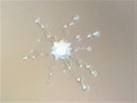that was my fear what would be the cheapest and easiest way to get rid of it? im megabroke right now and well i dont really have any money to spend on it lOl stupid lights being so expensive! gosh!
You can siphon it out while scraping it gently against the glass with a rubber tube
is there anyway to possibly keep it from comig back? i got the tank used and when i first set it up there was a nice size piece sticking up in the sand i did what u guys said and scoped it up and the area around it and now it looks like im getting more! so i wa wondering if i remove these two what would be the best way to keep it undercontrol if it starts to come back? pep shrimp?
Pep shrimp are a shoot and miss they wiped my tank of them but turned on my snails when they gto hungry
Make a kalk paste and apply to area. The high pH will kill it. They will not come back but there may be more yet to show.
And just in case you’re too broke to make kalk paste, you can make an salt paste that will o the same thing. Boiling water & vinegar work as well.
Or lemon juice injections.
Some guy usually gives out free kalk at all the meetings.
ian does that mean ur offereing to give me free kalk at the meeting? ![]()
Sounds like a deal.
grr type try number 3 okay so i have a small either anemone or mushroom growing on a piece of lr will make short so this wont close… purplish color size of pencil easer has 3 white circles almost in it with white dots… found one at petkare once and couldnt figure out what it was any ideas?
it looks alot different then both of the pieces of aptasia in the tank cant get a pic cuz its to small
okay so i was wrong it does have tenicals but it comes out at night when i turned on the lights this morning it was open for about 30 seconds than closed up with the light it has tenicals that have little white balls on the end
[quote=“Jocephus, post:12, topic:1011”]
My best guess…

Look close?[/quote]
Sounds like Joe may be right.
it kinda does if that has each white spot being its own tenical and it doesnt like light! what is that?
Hydriod Colonial, plant-like animals closely related to jellyfish, with stinging cellsany member of the invertebrate order Hydroida (class Hydrozoa, phylum Cnidaria). Hydroids have three basic life-cycle stages: (1) a tiny free-swimming planula larva about 1 mm (0.04 inch) long, which settles and grows into (2) a sessile (attached), usually colonial hydroid stage, which in turn liberates (3) medusae. This cycle is exemplified by the genus Obelia , whose members are widely distributed throughout the world. Many hydroids have, through evolution, suppressed the medusa by retaining it on the sessile hydroid colony. Colonies of hydroids are typically 5 to 500 mm (0.2 to 20 inches) or more high and are branched; the branches bear the individuals, or zooids (hydroid polyps). Each zooid consists of a tubular body that has two layers separated by a thin, jellylike mesoglea (layer of connective tissue), a terminal mouth, and surrounding circlet(s) of tentacles. The zooids are joined basally to a common living tube called the stolon that runs the length of the colony. The living tube, which is assumed to permit the exchange of food between individuals, is protected within a tough, chitinous sheath, the perisarc. Colonies of hydroids grow vegetatively by increase in the number of hydranths, but sexual reproduction also occurs. Reproductive polyps (gonozooids) occur intermittently on the colony. They release either planula larvae or medusae, depending on the species. Some species can retract their polyps within a protective extension of the perisarc, the hydrotheca, but others lack such a structure. Most hydroids inhabit marine environments, but some have invaded freshwater habitats. An example is the Hydra, which is further unusual in being solitary. There are about 2,000 species of hydroids.-Britannica
so that sounds kinda bad what should i do 2 kill it? use a needle and inject it with high concentrated salt water?
If it is a hydroid, it will die in a week or two on it’s own, but any of the techjniques for aiptasia will work here as well.
it wont reproduce? im afraid if i have 1 i have more, also afraid i have more aptasia than what im seeing!
Hydroids usually show up for a week or two, then magically disappear. They’re one of those hitchikers that don’t fare well long term in most tanks (some are really cool). For the aiptasia, I would get a couple of peppermint shrimp. They do a great job keeping them at bay. For that matter, aiptasias aren’t bad until they’re in large numbers. Sometimes they spread rapidly, that’s why everyone advocates killing them quickly. But having one or two in your tank won’t hurt anything. The real problem is that they have stinging tentacles and will harm less aggressive corals.